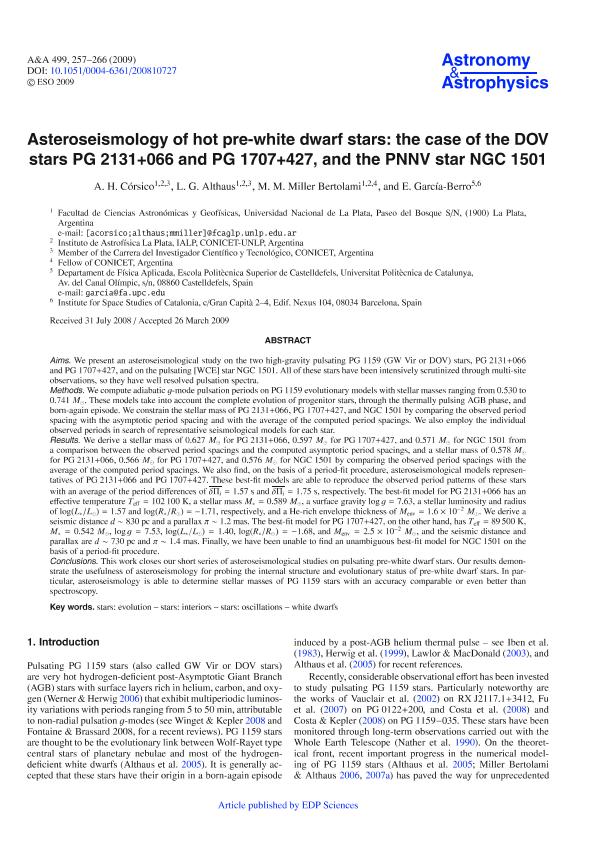Artículo
Asteroseismology of hot pre-white dwarf stars: the case of the DOV stars PG 2131+066 and PG 1707+427, and the PNNV star NGC 1501
Corsico, Alejandro Hugo ; Althaus, Leandro Gabriel
; Althaus, Leandro Gabriel ; Miller Bertolami, Marcelo Miguel
; Miller Bertolami, Marcelo Miguel ; García Berro, Enrique
; García Berro, Enrique
 ; Althaus, Leandro Gabriel
; Althaus, Leandro Gabriel ; Miller Bertolami, Marcelo Miguel
; Miller Bertolami, Marcelo Miguel ; García Berro, Enrique
; García Berro, Enrique
Fecha de publicación:
05/2009
Editorial:
EDP Sciences
Revista:
Astronomy and Astrophysics
ISSN:
0004-6361
Idioma:
Inglés
Tipo de recurso:
Artículo publicado
Clasificación temática:
Resumen
Aims. We present an asteroseismological study on the two high-gravity pulsating PG 1159 (GW Vir or DOV) stars, PG 2131+066 and PG 1707+427, and on the pulsating [WCE] star NGC 1501. All of these stars have been intensively scrutinized through multi-site observations, so they have well resolved pulsation spectra. Methods. We compute adiabatic g-mode pulsation periods on PG 1159 evolutionary models with stellar masses ranging from 0.530 to 0.741 M. These models take into account the complete evolution of progenitor stars, through the thermally pulsing AGB phase, and born-again episode. We constrain the stellar mass of PG 2131+066, PG 1707+427, and NGC 1501 by comparing the observed period spacing with the asymptotic period spacing and with the average of the computed period spacings. We also employ the individual observed periods in search of representative seismological models for each star. Results. We derive a stellar mass of 0.627 M for PG 2131+066, 0.597 M for PG 1707+427, and 0.571 M for NGC 1501 from a comparison between the observed period spacings and the computed asymptotic period spacings, and a stellar mass of 0.578 M for PG 2131+066, 0.566 M for PG 1707+427, and 0.576 M for NGC 1501 by comparing the observed period spacings with the average of the computed period spacings. We also find, on the basis of a period-fit procedure, asteroseismological models representatives of PG 2131+066 and PG 1707+427. These best-fit models are able to reproduce the observed period patterns of these stars with an average of the period differences of δΠi = 1.57 s and δΠi = 1.75 s, respectively. The best-fit model for PG 2131+066 has an effective temperature Teff = 102 100 K, a stellar mass M∗ = 0.589 M, a surface gravity log g = 7.63, a stellar luminosity and radius of log(L∗/L) = 1.57 and log(R∗/R) = −1.71, respectively, and a He-rich envelope thickness of Menv = 1.6 × 10−2 M. We derive a seismic distance d ∼ 830 pc and a parallax π ∼ 1.2 mas. The best-fit model for PG 1707+427, on the other hand, has Teff = 89 500 K, M∗ = 0.542 M, log g = 7.53, log(L∗/L) = 1.40, log(R∗/R) = −1.68, and Menv = 2.5 × 10−2 M, and the seismic distance and parallax are d ∼ 730 pc and π ∼ 1.4 mas. Finally, we have been unable to find an unambiguous best-fit model for NGC 1501 on the basis of a period-fit procedure. Conclusions. This work closes our short series of asteroseismological studies on pulsating pre-white dwarf stars. Our results demonstrate the usefulness of asteroseismology for probing the internal structure and evolutionary status of pre-white dwarf stars. In particular, asteroseismology is able to determine stellar masses of PG 1159 stars with an accuracy comparable or even better than spectroscopy.
Palabras clave:
Evolution of Stars
,
Interior Stars
,
Oscillations
,
White Dwarfs
Archivos asociados
Licencia
Identificadores
Colecciones
Articulos(IALP)
Articulos de INST.DE ASTROFISICA LA PLATA
Articulos de INST.DE ASTROFISICA LA PLATA
Citación
Corsico, Alejandro Hugo; Althaus, Leandro Gabriel; Miller Bertolami, Marcelo Miguel; García Berro, Enrique; Asteroseismology of hot pre-white dwarf stars: the case of the DOV stars PG 2131+066 and PG 1707+427, and the PNNV star NGC 1501; EDP Sciences; Astronomy and Astrophysics; 499; 1; 5-2009; 257-266
Compartir
Altmétricas



